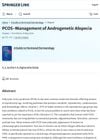Search
forProducts matching "hair loss management"
Tracking 2 products like 35 Keeps Thickening Conditioner and 115 Ketocolost shampoo from by companies like Keeps and Minoxidil Express. View all 2 products »
Sort by
Research
180-210 / 1000+ results
research Low-Level Light and Minoxidil 5% Combination Versus Either Modality Alone in Management of Female Patterned Hair Loss: A Randomized Controlled Study
Combining low-level light therapy and minoxidil 5% is more effective for female hair loss than using either treatment alone.

research Recent Advances in Understanding of the Etiopathogenesis, Diagnosis, and Management of Hair Loss Diseases
New understanding and treatments for hair loss are improving, but more research is needed.

research Successful Management of Hair Loss with Ayurvedic Treatment – A Case Study
Ayurvedic treatment improved hair growth in a person with hair loss.
research Overview and Approach to Medical Management of Male Pattern Hair Loss
research Commentary on Clinical Use of Extracellular Vesicles in the Management of Male and Female Pattern Hair Loss: A Preliminary Retrospective Institutional Review Board Safety and Efficacy Study

research A Management Model to Promote Hair Growth for Androgenetic Alopecia Cases Through Yoga and Ayurveda
Yoga and Ayurveda, including stress management and herbal oil use, can potentially reduce hair loss and promote hair growth, with further research needed for therapy protocols.

research Management of Hair Problems
Dr. Vera H. Price's 1979 work emphasizes the importance of accurate diagnosis and personalized treatment for hair loss.

research Hair Loss in Infancy and Childhood
The document concludes that proper diagnosis and management of hair loss in children require a detailed examination and understanding of various hair disorders.

research The Impact of Hair Loss in Cambodia: Causes, Prevention Methods, and Treatment Solutions
A combined approach of medical treatments, natural remedies, diet, and stress management is best for hair regrowth in Cambodia.

research An Overview of Management of Drug-Induced Hair and Nail Disorders
Cooling the scalp may prevent hair loss from chemotherapy, hair often grows back after treatment, and nail issues usually improve after stopping the drug.

research Hair: What Is New in Diagnosis and Management?
Female pattern hair loss diagnosed by scalp appearance, treated with combined therapies and targeted approaches.

research Age-Related Hair Changes in Men: Mechanisms and Management of Alopecia and Graying
Men's hair loss is caused by hormones and genes, and can be treated with medication and surgery, while graying is due to aging and has no prevention except dyeing.

research Hereditary 1,25-Dihydroxyvitamin D-Resistant Rickets (HVDRR): Clinical Heterogeneity and Long-Term Efficacious Management of Eight Patients from Four Unrelated Arab Families with a Loss of Function VDR Mutation
Patients with the same genetic mutation for vitamin D-resistant rickets showed different symptoms but all improved with treatment except for hair loss.

research Hair Fall and Its Homeopathic Management
Homeopathic treatments can effectively manage hair loss and improve well-being.

research Development and Evaluation of Finasteride Niosomes Targeting Hair Follicles for Androgenic Alopecia Management
Finasteride niosomes were developed and found to be effective in treating hair loss, with better results than commercial minoxidil, and could be a promising topical treatment for hair loss.

research Toward Optimal Health: The Experts Respond to Hair Loss in Women
Hair loss in women is often due to hereditary conditions or stress, and while treatments like minoxidil can help, diagnosis and management require medical guidance.

research Exploring the Potential of Eclipta Alba: A Promising Approach for Hair Treatment Management Through 5-Alpha Reductase Inhibition
Eclipta alba extract could be a promising natural treatment for hair loss.

research A Cross-Sectional Descriptive Study to Investigate the Pattern and Grading of Female Pattern Hair Loss in Polycystic Ovarian Syndrome Patients
12.5% of women with PCOS experience moderate hair loss, highlighting the need for early detection and management.

research Chemotherapy-Induced Alopecia Management: Clinical Experience and Practical Advice
The conclusion is to use scalp cooling, gentle hair care, and treatments like minoxidil for managing hair loss from chemotherapy, and stresses the need for more research and collaboration in this area.
research Clinical Manifestations and Management of Acute Thallium Poisoning
Thallium poisoning causes pain, hair loss, and nerve issues, treatable with hemoperfusion and hemodialysis.

research Oxidative Stress Management in the Hair Follicle: Could Targeting NRF2 Counter Age-Related Hair Disorders and Beyond?
Activating NRF2 might help treat hair disorders by improving antioxidant defenses.

research Hair Loss in Children
Children's hair loss can be caused by many factors, including autoimmune diseases, emotional stress, genetics, and infections, with treatment and prognosis varying.

research Clinical Recognition and Management of Alopecia in Women of Color
The document concludes that it's important to recognize and treat hair loss in women of color, considering their unique hair characteristics and psychological impact.

research Management of Autoimmune-Associated Alopecia Areata
Treatments for autoimmune hair loss have limited success and often relapse, and emotional support is crucial for those affected.

research Complications of Hair Restoration Surgery: An Overview
Hair restoration surgery can lead to issues like scarring, hair loss, and anxiety, but careful management before and after the procedure can minimize these complications.

research PCOS Management of Androgenetic Alopecia
Hair loss in women with PCOS is linked to high androgen levels but the relationship is unclear.

research Surgical Management Of Scarring Alopecia
Hair loss due to scarring can be treated by reducing inflammation, removing scar tissue, and transplanting hair. The Follicular Unit Extraction technique is effective but requires skill and time. Future focus should be on scar-less healing methods.

research The Challenging Consultation: Management of Melanoma
The conclusion is that managing hair loss conditions like FFA and melanoma requires individualized approaches, considering new findings and balancing treatment benefits with potential risks.

research Hair Loss in Children: Etiologies and Treatment
Early treatment of children's hair loss, which can be caused by various factors, is important due to its emotional impact.